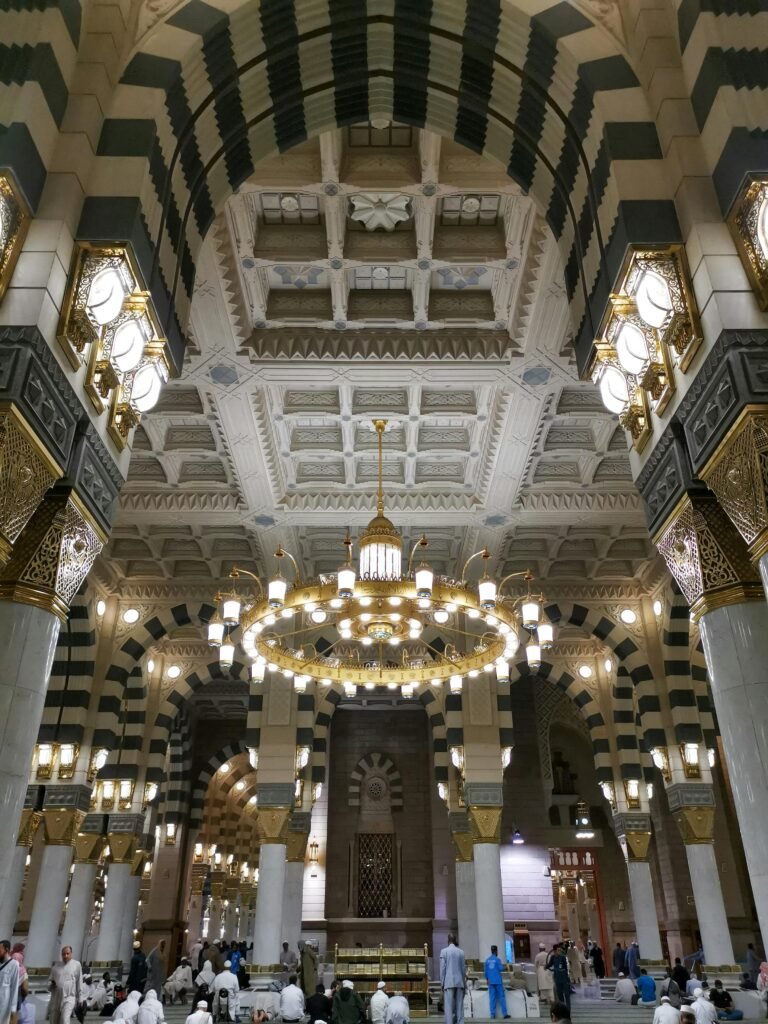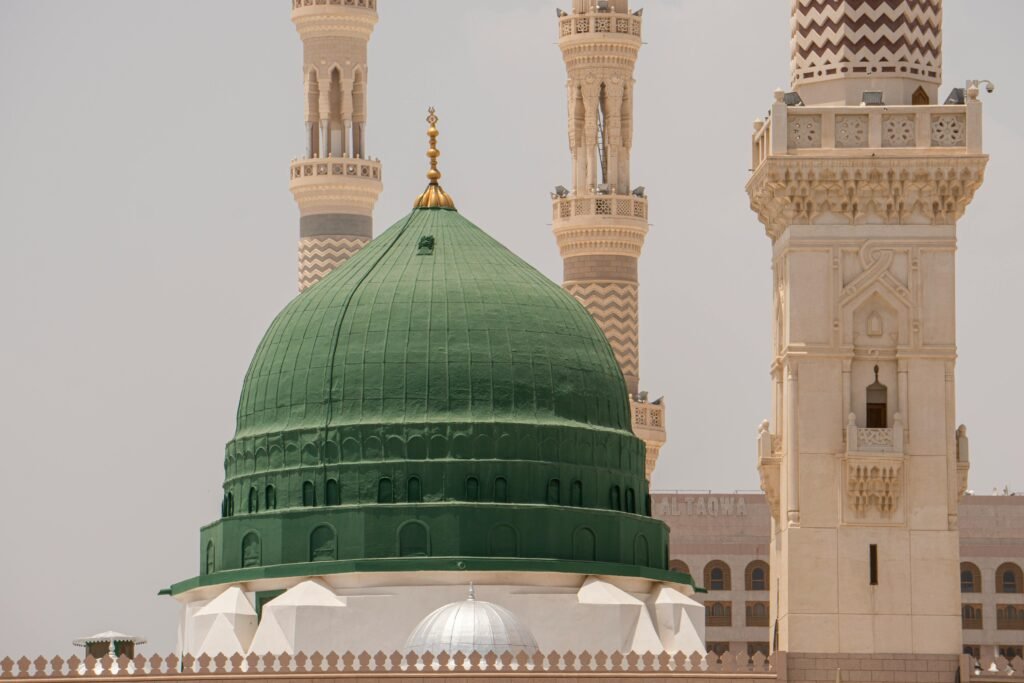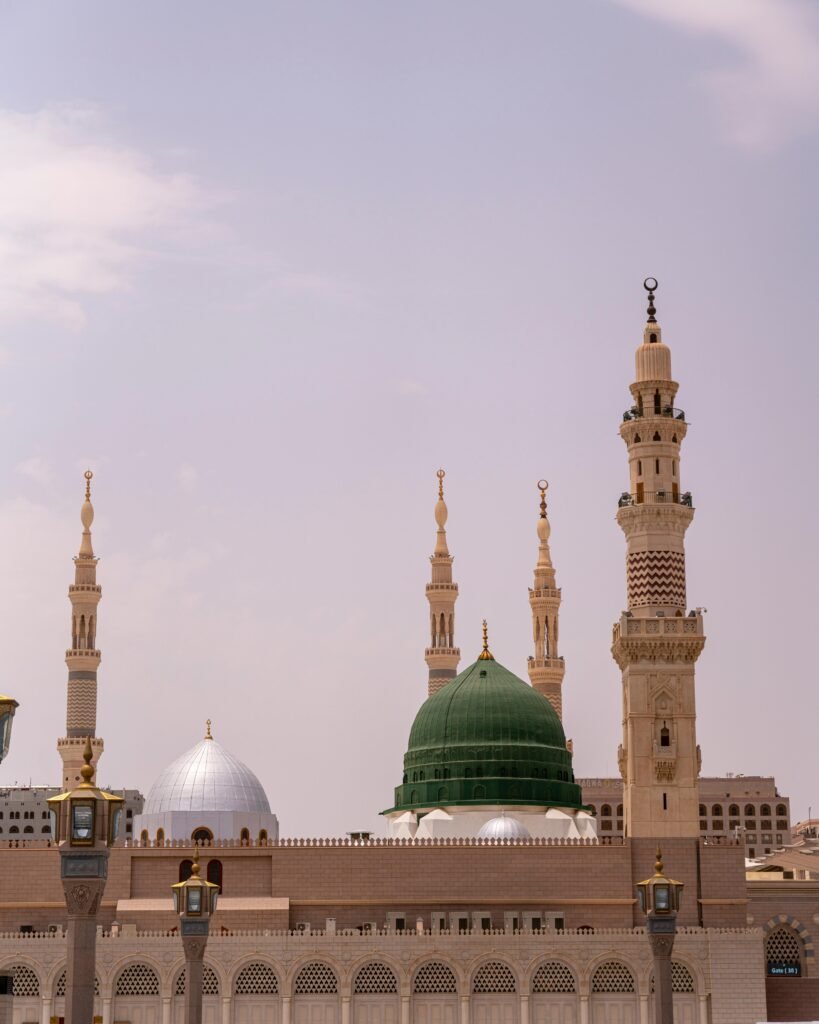The word “Rawdah” means garden. Here, Rawdah or garden refers to “a garden of paradise.” Since the Prophet’s grave is filled with the blessings of paradise, it is called “Rawdat-al-Athar” in this sense.
Location of Rawdah
In the hadiths of Bukhari and Muslim, the Messenger of Allah (peace be upon him) said:
ما بين بيتي ومنبري روضة من رياض الجنة
Meaning: “The area between my house and my pulpit is a garden from the gardens of paradise.” The importance and value of this Rawdah are clearly understood from this hadith. The length of Rawdah is 22 meters, and its width is 15 meters.
In the hadith, the Prophet’s house refers to a specific room, which is the room of Hazrat Aisha. Because, in another hadith, it is mentioned, “The area between my grave and my pulpit is a garden from the gardens of paradise.” The Prophet’s grave is in Hazrat Aisha’s room. Based on this hadith, there are three opinions regarding Rawdah:
- Rawdah refers to the entire mosque that existed during the Prophet’s time.
- The area between the Mihrab and the chamber is Rawdah. It is wide on the side of the chamber and narrow on the side of the pulpit. As a result, it takes on a triangular shape, with the mihrab on the Qibla side and the chamber opposite.
- The middle area along the boundaries of both sides is Rawdah, which is square-shaped. Therefore, the front part of the mosque towards the Qibla, i.e., the southern part where the pulpit is located, extends east-west as Rawdah, although it is not straight along the chamber. On the contrary, the entire area from the northern boundary of the chamber to the pulpit, extending east-west, is Rawdah, even though it is not straight along the pulpit. Based on this, it is considered a square area.
Virtues of Rawdah
The statement “Rawdah is a garden of paradise” has different interpretations:
- Hafiz Ibn Hajar mentioned that scholars did not take the literal meaning but interpreted it metaphorically. According to them, participating in gatherings of dhikr here brings mercy and fortune, making it as though it is a garden of paradise. This was especially applicable during the Prophet’s time, as participants directly gained mercy and fortune.
- Worship in Rawdah reaches the gardens of paradise. In this sense, it is metaphorical.
- It can also be taken literally, meaning Allah will transfer this place exactly to paradise. This third opinion is held by Ibn Najjar and Imam Malik. A group of scholars also share this view, stating that the part of Rawdah is not like other ordinary land. The last interpretation is stronger since the first and second interpretations can apply to other acts of worship as well, which would not make Rawdah unique.
Ibn Abi Jamrah, aiming to reconcile the differences, mentioned that there is no contradiction in the enhanced reward described for the Prophet’s Mosque. The virtues of Rawdah are the highest, and there is no obstacle to transferring this area exactly to paradise. The purpose of highlighting the sacred place is so we can keep it vibrant through worship.
- This area is essentially a garden of paradise, just as the Black Stone (Hajr-e-Aswad) is a stone from paradise. Later, this area will be transferred to paradise, and whoever performs good deeds here will gain a garden of paradise. Perhaps Allah honored Muhammad (peace be upon him) and his forefather Ibrahim (peace be upon him) by granting the Black Stone from paradise to Ibrahim and a garden of paradise to Muhammad.
Grave Restoration
The governor of Madinah, Umar bin Abdul Aziz, himself initiated the restoration of the grave. He ordered his servant, Mozahim, to undertake the repairs.
Abdullah bin Uqayl narrated: On a rainy night, while returning from the house of Mughirah bin Shu’bah, I perceived a fragrance that I had never smelled before. He immediately went to the Prophet’s Mosque and saw that the eastern part of the grave had collapsed. After offering salam, he left immediately. Umar bin Abdul Aziz ordered the damaged area to be covered with Kabati cloth overnight.
The next morning, he summoned the mason Wardan. Wardan requested an assistant, but Umar bin Abdul Aziz himself prepared to assist. However, Qasim bin Muhammad and Salem bin Abdullah also prepared to help Wardan. Umar bin Abdul Aziz asked them, “What will you do?” They replied, “We will accompany you into the grave.” He said, “No, we will not enter the grave with so many people to avoid causing distress.” He instructed only Mozahim to enter the grave and assist Wardan.
Wardan, while digging the foundation of the wall, saw a foot and retreated. Umar also became worried. Then Abdullah bin Ubaydullah said, “Do not be alarmed by the sight of your grandfather Umar bin Khattab’s foot. Since there wasn’t enough space in the chamber, the wall’s foundation was carved to place his feet.” He instructed Wardan to cover the feet, after which the grave was repaired, and the damaged area was fixed.
Beautification of the Pillars of Rawdah
The Turkish Sultan Selim (died 945 AH, corresponding to 1541 AD) covered the pillars of Rawdah with half white and half red marble stones and decorated them with gold to make them radiant. Later, during the renovation of the mosque by Sultan Abdul Majid, the roof of Rawdah was repaired, and the stones were retained. The stones were further brightened during this time. However, some stones broke during the repair work, and some pillars were not covered with marble stones. Designs similar to those with marble stones were drawn on those pillars, indicating that they once had marble stones. The white-designed pillars are subtle markers of the northern boundary of Rawdah.



